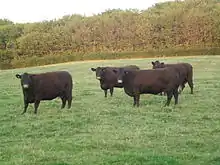Sussex cattle
The Sussex is a British breed of red beef cattle from the Weald of Sussex, Surrey and Kent, in south-eastern England. Its traditional use as a draught ox on the Weald continued into the twentieth century. From the late nineteenth century it began to be selectively bred for beef production. It has been exported to many countries of the world; the largest population is in South Africa.[1]:306 It has a thin summer coat and many sweat glands, but grows a thick coat in winter, so is suited to both hot summers and cold winters. It has a placid temperament but can be very stubborn.
 Sussex cow | |
| Country of origin | England |
|---|---|
| Distribution | World-wide, especially English-speaking countries |
| Use | Beef, formerly draught |
| Traits | |
| Coat | Rich red-brown coat, with a creamy white switch to the tail. |
| Horn status | Naturally white horned. Polled Sussex cattle also bred. |
| |
History
The Sussex is one of several similarly coloured breeds of southern England – the others include the North Devon, the Hereford, the Lincoln Red and the Red Poll. All these breeds derive originally from the traditional multi-purpose red landrace cattle of the region. Ox ploughing continued longer in the Weald and on the South Downs than in most parts of England, and so the Sussex remained until relatively recently as heavy boned, large shouldered, draught animals.[2]
Arthur Young Junior wrote in the early 19th century that the cattle of the Weald "must be unquestionably ranked among the best of the kingdom".[3] William Cobbett in his Rural Rides also expressed surprise at finding some of the finest cattle on some of the most impoverished subsistence farms on the High Weald. The breed was numerous in Kent and the Wealden parts of Surrey as well as in Sussex in the late 18th century when Arthur Young toured Sussex and praised the breed in his book Agriculture of Sussex of 1793. He stayed at Petworth House where the progressive 3rd Earl of Egremont established a Sussex herd in Petworth Park which is still there today. High corn prices during the Napoleonic Wars led to a lot of grassland on the Low Weald being ploughed up and cattle herds greatly declined. Later in the 19th century rail transport caused an increase in dairy farming to supply the London market with a consequent decline in beef cattle breeding. A herd book was established in 1874.
Sussex cattle worldwide

Great Britain
The stronghold of Sussex cattle in Britain remains the Wealden counties of Sussex, Kent and Surrey, but they are not particularly common even there, and are rare elsewhere in Great Britain. The Royal Farms in Windsor Great Park raise pure bred Sussexes.[4]
Australia
The breed is used in Australia, where it arrived in the early 1970s. A polled strain has been selected.[5]
New Zealand
Introduced into New Zealand in 1970[7] they are classed as a rare breed with only three breeders listed.
South Africa
The breed was introduced to South Africa in the early twentieth century[8] and is popular in the North West Province where the breed society has its headquarters in Klerksdorp.
Characteristics
The Sussex has a rich red-brown coat, with a creamy white switch to the tail. It is a medium-sized, long-bodied animal, and traditionally it has white horns, although naturally polled strains have also been developed.
References
- Valerie Porter, Lawrence Alderson, Stephen J.G. Hall, D. Phillip Sponenberg (2016). Mason's World Encyclopedia of Livestock Breeds and Breeding (sixth edition). Wallingford: CABI. ISBN 9781780647944.
- J P Boxall, p18 The Sussex Breed of Cattle in the Nineteenth Century
- Rev. A. Young, General View of the Agriculture of the County of Sussex, 1813, p. 226.
- High Quality Beef, Pork and Lamb from the Royal Farms
- Willyung Poll Sussex Stud
- Sussex cattle in Alberta
- Rare breeds website
- Breed history in South Africa Archived 25 May 2007 at the Wayback Machine
- Tennessee State Library and Archives
External links
- UK Sussex Cattle Society
- The Sussex Breed of Cattle in the Nineteenth Century by J P Boxall